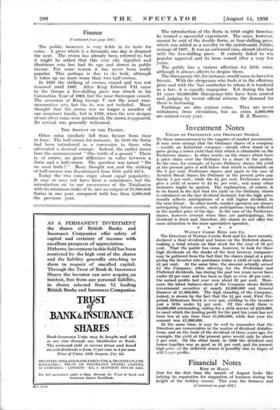The Public's Taste in Coins
THE great public interest shown in the approaching new coins of King Edward VIII, the designs of which are said to have been approved by His Majesty, is indiCative of the changing attitude of the English people towards the coinage.
During recent years there has been a marked increase in the interest taken by the public generally in the designs of the coinage and this has been accompanied by:a rise in their standard of judgement and taste: This change is in a_ large measure due to the efforts of the Royal Mint itself which has encouraged a wider interest in designs for coin„ and medals. For some years an expert Advisory Committee has worked with the Mint and -fo this COminittie fill designs are submitted. Young artists are urged to send :in designs, and if these show any degree of promise ,every assistance and en- couragement are forthcoming. - - • The Chancelkir of the. Exchequer has annotinced that, as 'usnal,- -specimen =sets of the first issue of the' new Edwardian coins will be issued in due course. For collectors, and Others requiring them, sets containing gold coins will-he available at special prices:- .7-The Royal Mint is already receiving enquiries for the new coins.
These specimen coins- will be carefully struck and packed in eases.:l'Itany will be kept permanently as souvenirs. but; _human nature being what -it. is, after a while it will be found that a number of these coins will be taken from their Cabinets. to perform their humbler dutieS as current coins of the realm.
THE FIVE SHILLING PIECE. „
Remarkable- ublic - interest was -shown -in the special Jubilee crowns iSsued last _year. Twenty-five pattern crowns .were struck. in gold "and, although the price was £50, there were no fewer thanT1,329 applicants for these. Two thougand •five Inniare'd-iSattern pieceS were struck in silver and sold for ri.s, 64---The applicants for theie numbered thousands. Some of these coins were soon on the market and prices reached fantastic heights. In 'addition ordinary currency crowns of the -Jubilee design were issued and no leiVer..than 150,000 of :these were struck within.a. month .9.f. the. Jubilee., _ It, seems prohahle that -a-jsimilar interest willshown in the new 1987 coinage.
(Continued on page 290.)
Finance
(Continued from page 288.)
The public, however, is very fickle in its taste for coins. A piece which is a favourite one day is despised the next. The crown has already been referred to, but it might be added that this very old, dignified and illustrious coin has had its • ups and downs in public favour. For some reason it has never been really popular. This perhaps' is due to its bulk, although it takes up no more room than two half-crowns.
In 1851 the striking of crowns ceased and was not resumed until 1887. After King Edward VII came to the throne a five-shilling piece was struck in his Coronation Year of 1902; but the issue thereupon ceased. The accession of King George V' saw the usual com- memorative sets, but the 5s. was not included. Many thought that the crown was no longer a member of our monetary family, but in 1928, when the new designs of our silver coins were introduced, the crown reappeared. Its revival was generally welcomed. -
THE ADVEN"F OF THE FLORIN.
Other coins similarly fall from favour from time tb time. The half-crown for instance. In 1849 the florin had been introduced as a concession to those who advocated a decimal coinage. Indeed, the earlier issues bore the announcement " One tenth of a pound." There is, of course, no great difference in value between a florin and a half-crown. The question was raised " Do we need both ? " .. Many thought not, and the striking of half-crowns was discontinued from 1851 until 1874.
Today the two coins enjoy about equal popularity. It may or may not have been a coincidence, but the introduction on to our racecourses of the Totalisator with its minimum stake of 2s. saw an output of 21,000,000 florins in one year, compared with less than 5,000,000 the previous year.
The introduction of the florin in 1849 might therefore be termed a successful experiment. The same, however, cannot be said of the double florin, _or four-shilling piece, which was added as a novelty to the' unfikunite Jubilee coinage df '1887. It was 811 awkward`coin, almost identical with the five-shilling piece. It entirely failed to win popular approval and its issue ceased after a very few
years. . • The public has a curious affection for little coins, although it always affects to despise them.
The threepenny-bit, for instance, would seem to have few friends. With the clergyman who finds it in the offertory plate and with the 'bus conductor to whom it is tendered as a fare, it is equally unpopular. Yet during the kit 15 years 65,000,000 threepenny-bits have been minted and, judging by recent official returns, the demand fOr them is increasing.
Farthings are also curious coins. They are never withdrawn from circulation, but an extra 5,000,000







































 Previous page
Previous page